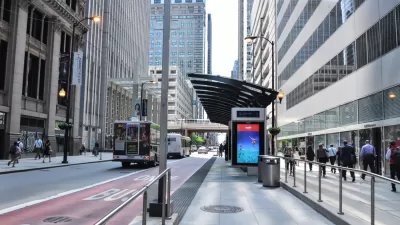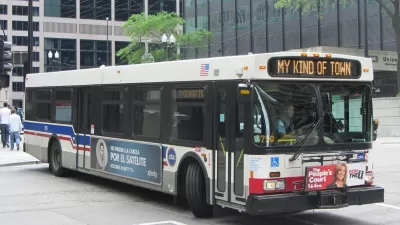Bus rapid transit (BRT) is well known among planners as a cheap method to improve bus service and provide an alternative to rail, but BRT projects around the country have met resistance from an array of status quo interests.
Yonah Freemark argues in favor of a more widespread adoption of bus rapid transit (BRT). “With projects like BRT, we have an opportunity to play to the great advantages of dense, urban environments, where transit is truly effective in connecting people to jobs and other needs, if given the chance to thrive.”
Freemark details the benefits of removing bus traffic from automobile traffic, and cites the successes of BRT projects. For example, “in city after city, BRT services have indeed increased ridership,” and “businesses fearful of fewer cars driving down streets with BRT should comfort themselves with the fact that more transit users typically means more economic activity, not less.”
Freemark drills a little deeper on the example of Chicago’s BRT line on Ashland Avenue: “For people living near several stations, the number of jobs accessible within a 20-minute transit commute would increase by more than 80 percent. The line itself would increase the number of people living and working within a quarter mile of a rapid transit station by 80,000 and 25,000, respectively.”
FULL STORY: Why More U.S. Cities Need to Embrace Bus-Rapid Transit

Alabama: Trump Terminates Settlements for Black Communities Harmed By Raw Sewage
Trump deemed the landmark civil rights agreement “illegal DEI and environmental justice policy.”

Planetizen Federal Action Tracker
A weekly monitor of how Trump’s orders and actions are impacting planners and planning in America.

The 120 Year Old Tiny Home Villages That Sheltered San Francisco’s Earthquake Refugees
More than a century ago, San Francisco mobilized to house thousands of residents displaced by the 1906 earthquake. Could their strategy offer a model for the present?

In Both Crashes and Crime, Public Transportation is Far Safer than Driving
Contrary to popular assumptions, public transportation has far lower crash and crime rates than automobile travel. For safer communities, improve and encourage transit travel.

Report: Zoning Reforms Should Complement Nashville’s Ambitious Transit Plan
Without reform, restrictive zoning codes will limit the impact of the city’s planned transit expansion and could exclude some of the residents who depend on transit the most.

Judge Orders Release of Frozen IRA, IIJA Funding
The decision is a victory for environmental groups who charged that freezing funds for critical infrastructure and disaster response programs caused “real and irreparable harm” to communities.
Urban Design for Planners 1: Software Tools
This six-course series explores essential urban design concepts using open source software and equips planners with the tools they need to participate fully in the urban design process.
Planning for Universal Design
Learn the tools for implementing Universal Design in planning regulations.
Clanton & Associates, Inc.
Jessamine County Fiscal Court
Institute for Housing and Urban Development Studies (IHS)
City of Grandview
Harvard GSD Executive Education
Toledo-Lucas County Plan Commissions
Salt Lake City
NYU Wagner Graduate School of Public Service




























